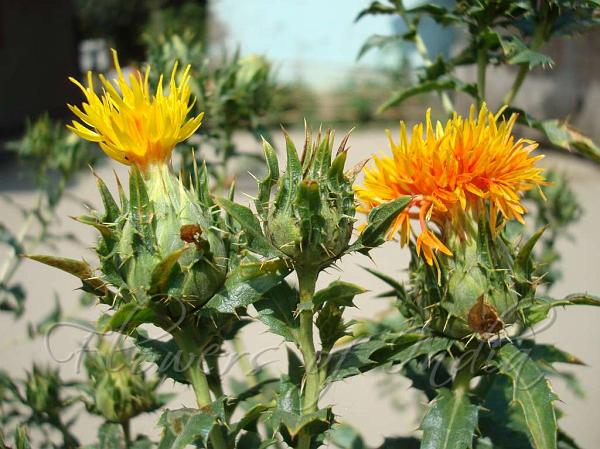|
| Safflower |
|

|

|
|
|
Photo: Sobhapati Samom |
Botanical name: Carthamus tinctorius Family: Asteraceae (Sunflower family)
Synonyms: Carduus tinctorius, Centaurea carthamus, Carthamus tinctorius var. tinctorius
Synonyms: Carduus tinctorius, Centaurea carthamus, Carthamus tinctorius var. tinctorius
Safflower is an annual plant native to the Mediterranean countries and
cultivated in Europe and the U.S. Its glabrous, branching stem grows from 1 to
3 feet high and bears alternate, sessile, oblong, or ovate-lanceolate leaves
armed with small, spiny teeth. The orange-yellow flowers grow in flower heads
about 1 to 11/2 inches across. This thistle is valued for its orange-yellow
flowers in summer and for the oil contained in its seeds.
The orange-red flowers of safflower sometimes serve as a substitute for
saffron, since they give a (rather pale) colour to the food. They are
frequently sold as “saffron” to tourists in Hungary or Northern Africa (and
probably many other parts of the world) Their value as spice is nearly nil,
but their staining capability justifies usage in the kitchen.
Medicinal uses: Taken hot, safflower tea produces strong
perspiration and has thus been used for colds and related ailments. It has
also been used at times for its soothing effect in cases of hysteria, such
as that associated with chlorosis. Powdered seeds made into a poultice
used to ally inflammation of the womb after child birth.
Flowers of this herb is useful for jaundice.
Taken hot, safflower tea produces strong
perspiration and has thus been used for colds and related ailments. It has
also been used at times for its soothing effect in cases of hysteria, such
as that associated with chlorosis. Powdered seeds made into a poultice
used to ally inflammation of the womb after child birth.
Flowers of this herb is useful for jaundice.
Medicinal uses:
 Taken hot, safflower tea produces strong
perspiration and has thus been used for colds and related ailments. It has
also been used at times for its soothing effect in cases of hysteria, such
as that associated with chlorosis. Powdered seeds made into a poultice
used to ally inflammation of the womb after child birth.
Flowers of this herb is useful for jaundice.
Taken hot, safflower tea produces strong
perspiration and has thus been used for colds and related ailments. It has
also been used at times for its soothing effect in cases of hysteria, such
as that associated with chlorosis. Powdered seeds made into a poultice
used to ally inflammation of the womb after child birth.
Flowers of this herb is useful for jaundice. | Identification credit: Tabish | Photographed in Imphal, Manipur. |
• Is this flower misidentified? If yes,